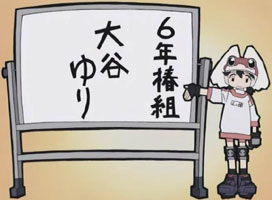|

We do get asked questions sometimes about anime and manga
(believe it or not) and we thought it'd be a good idea to give an area
where we can display our answers to them. This is in no particular
order so please feel free to have a look through. If you have any
question please e mail us with them (refer to e mail address at the foot
of the page) and we will attempt to answer them.
___________________________________________________________________________
Q. Why do some pictures in my graphic novel
appear in a different tone to the rest of the book?
A. When graphic novels are released in Japan
the first few pages of a graphic novel are in colour. However, when
translated into English the entire novel will often be released in
monochrome to save money, leading to the difference in tone in opening
pictures and at the start of some chapters.
Occasionally some graphic novels will keep the opening colour pages – such
as Akira. Up until recently this was a rare occurrence but ADV’s new
manga publications have the opening pages in colour.
Q. Why are some English manga printed the
wrong way round?
A. These have been reprinted in the Japanese
format of reading right-to-left instead of the Western style of
left-to-right. Reprinting this way means that images will not be
‘flipped’ – the images will be reversed which leads to picture being the
mirror opposite of it’s original print. This does occasionally lead
to mistakes of words or items in background appearing backwards.
Many Western mangas are now reprinted in the Japanese style, as it has
proven very popular with fans.
Q. What does OAV stand for?
A. ‘Original Animation Videos’. This is anime
created especially for the DVD and VHS formats and is not broadcast on TV
or in cinemas. These are very popular in Japan as they are often
extensions of a TV anime series that has finished and the fans have
demanded more, so the OAV will be aimed specifically at these fans.
Also known as OVA or ‘original video animation’.
Q. Why do school kids wear sailor suits?
A. This is the standard uniform across Japan.
They date back to 19th century Prussia, which is the country Japan based
its education system on.
Q. In some evening scenes in anime there's
a humming noise in the background, what is this?
A. In Japan there is an insect called a
Cicada which, when in large groups, produce this noise with it’s chirping.
It’s basically the Japanese equivalent of a Grasshopper and it can be
heard whenever there is warm weather.
Q. Why do anime and manga characters sweat so
often?
A. The characters are not hot but simply
embarrassed, confused, uncomfortable or in the middle of an awkward
silence. Japanese people are often too polite to say what they are
thinking and sweat represents their discomfort.
Q. Why do so many male characters have
nosebleeds?
A. In anime and manga a nosebleed represents
sexual excitement (it is thought to be a substitute for ejaculation),
which is why it often happens when male characters walk in on females
taking a bath...
Q. Why does an ‘X’ or ‘+ sign’ appear so often on
characters foreheads?
A. This represents a throbbing vein in the
character's forehead, showing their frustration or imminent outburst of
anger
Q. Characters are nude quite often. Why is that?
A. Nudity isn’t as big a deal in Japan as it
is in the West, communal baths are common and there's also the fan service
to take in to account (see Glossary) so to see a character taking a bath
or getting changed is not seen as unusual or gratuitous. However,
sex in anime will only be shown on TV in Japan at night.
Q. Why do characters appear without pubic
hair?
A. In Japan it is taboo to show pubic hair on
film - animated or otherwise. Generally sexual organs are censored
out with pixilation in Japanese anime, but this censorship is removed on
western releases. However, because the creators knew it would be
censored it is often the case that they don't bother drawing pubic hair in
or draw the whole area badly. This is one of the reasons that
characters in 'Hentai' films often seem younger than they are meant to be.
Pubic hair is occasionally seen in anime but it is rare.
Q. Some anime and manga is published
by Viz, is this the same Viz that do the UK comic?
A. No. Most definitely not. Viz Comics/Viz
Video is an American publishing and distribution company that happens
to share its name with the, errr... 'hilarious' UK comic. It is
possible that this fact has helped in preventing the US Viz from
ever releasing anime here (there are probably copyright issues over the
name)...
___________________________________________________________________________
If you have any questions regarding anime and manga then please e-mail
them to us at webmaster@animetion.co.uk
and we will do our best to answer them.
___________________________________________________________________________
|










